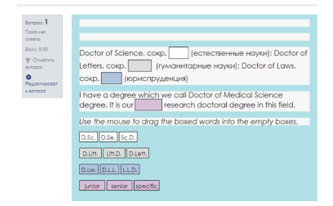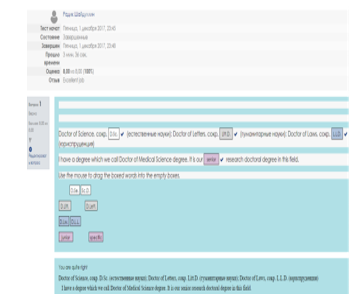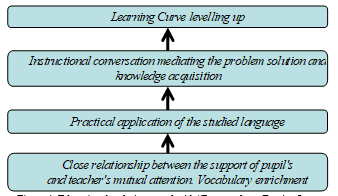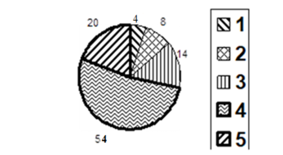Social-Interactive Learning Concept Used for Electronic Educational Resource “Post-Graduate Foreign Language” and the Obtained Learning Curve
Volume 5, Issue 4, Page No 655-659, 2020
Author’s Name: Natalya Chernova1,a), Victor Chernov1, Margarita Emelianova2, Raisa Akhunzianova3, Danil Sukhopluev1
View Affiliations
1Kazan (Volga Region) Federal University, Naberezhnye Chelny Institute, Naberezhnye Chelny, 423812, Russian Federation
2I.N. Ulianov Chuvash State University, Faculty of Foreign Languages, Cheboksary, 428015, Russian Federation
3Naberezhnye Chelny State Pedagogical University, Chair of Foreign Languages, Naberezhnye Chelny, 423806, Russian Federation
a)Author to whom correspondence should be addressed. E-mail: natalchern@gmail.com
Adv. Sci. Technol. Eng. Syst. J. 5(4), 655-659 (2020); ![]() DOI: 10.25046/aj050478
DOI: 10.25046/aj050478
Keywords: Educational process, Second language acquisition, E-learning, Participation, Zone of proximal development
Export Citations
The article touches upon an urgent question of social-interactive learning. The resource under study deals with one of the possible ways to solve this problem, in the context of global socio-cultural transformations and a new paradigm for the development of society. It is the formation of a subject-subject dialogue between a teacher and a student. The second language research study showed how pre-and intermediate speakers’ performance breaks down in the face of a difficult narrative task and self-regulation and control over the mediational means are lost. More advanced speakers are able to guide themselves through the task. The main idea of such education is that good learning leads to development. It seems to us important to refer the concept of the zone of proximal development to the development of the individual, which affects the boundaries of the zone of proximal development. Electronic educational resource with the help of mediating means or sign operations makes external social interactions become “internalized”, namely, internally reconstructed psychological processes – ways of thinking and learning A student identifies active personality development prospect through the actual experience. The students’ learning curve let us prove the idea that IT technologies intensify the process of studying, but should provide not only language accomplishments but active communication with a teacher as well.
Received: 27 June 2020, Accepted: 04 August 2020, Published Online: 25 August 2020
1. Introduction
This paper is an extension of work originally presented in 2017 10th International Conference on Developments in E-Systems Engineering (DeSE). The desire to find the right balance between the usage of electronic educational resources, direct participation on the part of a student and a learning curve determined the problem of our research. In theoretical terms, this is the problem of substantiating social-interactive learning concept in the electronic-digital form. In practical terms, it is the problem of determining the relationship between the success of training and the formation of a student’s personal qualities as a subject of educational activity [1]. We would like to develop the idea that constant transitions of external actions into internal ones and vice versa take place, not only constantly, but also contribute to penetration into the zones of proximal development, due to the expansion of the amplitude of oscillations, i.e. development and self-development of the subject itself (Popov L.M.) [2].
In Vygotsky’s understanding, this means that the personality is realized and manifested in all spheres of mental development in ontogenesis [3]. The actualization of personal characteristics, in particular, social orientation and personal abilities and qualities contributes to the subjective position formation (Leontiev A.N.) [4]. The development of the semiotic function is concretized in the ability to highlight in the text (in the broad sense of the word) the signified and the signifier; in the signified – the object and meaning, in the signifier – the form and content (meaning), which, in its turn, is the development of new levels of means mastery. Thus, it is necessary not only for the formation of scientific knowledge, but also for any spheres [5]. The “Post-graduate Foreign Language” electronic educational resource was developed according to the idea implying that a student should act, first of all, as a researcher of thinking, activity. Having mastered which, a student can successfully bring his/her random impressions about different phenomena of the surrounding world into a single system of verified judgments, grounded in understanding the essence of a particular sphere of reality (Luria A.R.) [6]. The main goal of a person is self-development, first of all, of personal qualities, without which the fulfillment of functional goals by a person is either impossible or of poor quality. This logic supposes the subjective activity of the student, who him/herself creates the teaching and makes him/herself, while the line between the processes of training and education is erased.
As it turns out, only instructional conversations relate human mental functioning to positioning themselves as individuals in carrying out a task in a foreign language (R. Donato). Computer assisted learning helps to move a focus from form to meaning. So, societal context participation (Zinchenko V.V.) [7] is implemented as social-interactive learning concept. The authors’ aim is to provide evidence of the relationship between the success of training and the usage of “Post-graduate Foreign Language” electronic educational resource, which provides additional opportunity for a student to be a subject of educational activity when learning a foreign language. “Participation” metaphor is the main tool used in the process of the program creation according to Social-interactive Learning Concept.
The “Post-graduate Foreign Language” electronic educational resource is an automated learning system, providing a socio-cultural approach (Vygotsky L.S.) to language learning [3]. In the first place, it is the opportunity of extemporary communication (i.e. Figure 4). Further, a student does not only gain some new knowledge in the subject but receives skills of various kinds. As a result, a student has an opportunity of realizing in practice a fundamental way of learning [8].
The study shows that “activity theory” (Leontiev A.N.) finds its application in e-teaching as well as classroom language learning [4]. The paradigm of “zone of proximal development” is followed through: 1) communicative language studying as a part of cognition; 2) semiotic mediation; 3) private speech. In analyzing the recorded interaction between the students and the teacher, it shows that instructional conversations are developmentally sensitive to the students’ growing ability to use the language required to carry out a specific task. The evidence of this is the shift from other-regulated to self-regulated error correction.
This computer training program can be presented as a systematic presentation of the above-mentioned approach to the process of studying, which compiles the fundamental provisions of the subject-activity approach and the socio-cultural theory with modern technologies in e-learning, such as Moodle software platform [1]. The choice of the studied subject is due to the necessity of fluent English for any scientist or a post-graduate.
The “Post-graduate Foreign Language” resource shows that Social-interactive Learning Concept can be reflected through metacognitive strategies such as predicting, planning, and monitoring. So, mediating learning with the help of IT technologies shows that the Learning Curve levels up in comparison with traditional learning strategies providing instructions alone. The succession and number of exercises help students and teachers as well help in the process of communicative and cognitive activities in an ESL class [8].
2. Background to the Problem
The program under study provides for independent work on the part of a student and work under the guidance of a teacher as well [2]. It helps in getting the necessary knowledge, gives an opportunity of providing effective dealing with the educational problem and allows active learning in natural environment. This computer-training program is a means of studying “Academic English” within the Post-graduate curriculum and meets all educational and methodological demands [7].
Referring to the private speech in his study, J. Smith (1996) operationalizes it as a ‘verbal attempt of self-regulation during problem-solving tasks’, which is, the result of stress that accompanies construction of the meaning in L1 or L2, the private speech is distinguishable from the interpersonal communication. Smith examines a grammar class of high intermediate ESL students and claims that private speech can arise in a discussion [9]. The thing is that classroom discourse is usually analyzed for its social, communicative value, neglecting the cognitive function of instructional talk.
 Figure 1: “My scientific research” item program
Figure 1: “My scientific research” item program
Classroom conversations depend on spontaneity, unpredictability and focus on new information. If the discussion is shaped toward a curricular goal, and teachers in their turns build or activate background knowledge in students, these conversations can also be instructional. They are relevant to language classrooms because they provide opportunities for experiencing language outside. The concept of instructional conversations was explored within the frames of a PhD study, compiled by N.A. Chernova. The motivation for the study was the following observation. It turned out that instructional conversations usually arose with fairly advanced ESL learners. The question remained, was it possible to have an instructional conversation in a beginning foreign language class? Limited linguistic resources are not available for a topically coherent, extended, and meaningful conversation. The following data were received. If a teacher followed a predictable pattern a) setting up the vocabulary practice exercise; b) completing textbook exercises using the new vocabulary; and с) spontaneous questions and comments by students and teacher embedded within the practice exercise, conversational communication was out of the question (Chernova & Mustafina, 2016) [7]. The possibility of such conversation depended on management talk and extension activities, which show features of it most consistently and impressively [10].
Here is the screen shot to illustrate Chapter 1 with the topic “My scientific research”. The tasks “Tell us about your Post-Graduate Course and Research work”, “Free communication online”, and “«A young scientist’s visiting card» Questions and answers” provide for Instructional conversations. The last one let the students keep in contact with the teacher.
The tests are checked automatically, but two-way communication is possible when fulfilling training tests. So, you keep in contact with the teacher in English. The fact that every stage is under control is the most prominent achievement with this resource.
 Figure 2: Chapter 1. Test №2. Fill in the gaps in the lecture material
Figure 2: Chapter 1. Test №2. Fill in the gaps in the lecture material
 Figure 3: The available marks for the fulfilled test
Figure 3: The available marks for the fulfilled test
There is some material in Russian in the test due to the need to check understanding. The items in the upper left-hand corner are given in Russian because of the application interface.
The “Post-graduate Foreign Language” resource makes it possible to estimate the test results at once. Thus, the process of training is intensified.
3. Methods of Research
The methodological basis for creating a program is the theory of D. Wood, J.S. Bruner, J. Ross and R. Donato about spontaneous communication in the classroom [11]. At the initial stage, students simply reproduce monosyllabic statements, repeating them after the teacher, and the invariable model of teaching in the classroom is “a teacher – students – a teacher”, or otherwise “subject-object-subject”. Over time, students have spontaneous responses to the teacher’s statements, as well as mutual assistance and joint construction of statements, the teacher’s help decreases, and students play an increasingly active role in the lesson, using the same techniques as the teacher [12].
 Figure 4: Educational technique used with “Post-graduate Foreign Language” electronic educational resource
Figure 4: Educational technique used with “Post-graduate Foreign Language” electronic educational resource
The Instructional conversation is a dialogue in which the speakers are involved in solving the problem in the process of acquiring knowledge [4]. We would like to emphasize that it mediates both the solution of the problem and the acquisition of knowledge. Growth in the quality of knowledge is the main result achieved. This is the tracked indicator presented in the study.
In the framework of the experimental program, the study was carried out. The experimental group, within the framework of this strategy, discussed their actions in a dialogue and corrected each other’s mistakes, explaining them. The results were compared with those of the control group the students of which studied the subject “Academic English” within the Post-graduate curriculum but didn’t use the “Post-graduate Foreign Language” electronic educational resource. The topics and the volume of material studied was the same. The class periods in both groups are fully alike. The quantitative values of the quality of knowledge obtained after the experimental study are presented in Figures 5, 6.
The study took place in Kazan Federal University. The participants were the first-year post-graduate students. The level of language proficiency was rather high in the second term by the time of the study. By this time a student can already use the specific vocabulary on their specialty in spontaneous dialogues. The study was aimed at testing the influence of “Post-graduate Foreign Language” electronic educational resource on the correct use of special language forms in oral speech.
4. Results of the Study and Discussion
The obtained changes in the quantitative characteristics of the quality of knowledge are statistically significant. The system of evaluation begins with 1 (equals to “Bad” mark) and finishes with 5 (equals to “Excellent” mark).
 Figure 5: Quality of knowledge. Control Groups. Control Survey
Figure 5: Quality of knowledge. Control Groups. Control Survey
 Figure 6: Quality of knowledge. Experimental Groups. Control Survey
Figure 6: Quality of knowledge. Experimental Groups. Control Survey
Taking into account that levels 4 and 5 are sufficient, it can be concluded that 74% of students in the Experimental Groups achieved this indicator, and 41.6% in the Control groups. Thus, the quality of knowledge in the Experimental Groups is almost 1.8 times higher than in the Control Groups.
This distribution allows us to speak about an increase in knowledge among students of Experimental Groups, which is expressed in the ability to notice and correct errors with minimal or no hint, take full responsibility for correcting errors, and be consistent in the use of keywords in all contexts.
The study shifts the governing concept of learning away from the acquisition metaphor toward the participation one with an individual’s activity. In other words, students are taking part in a collaborative dialogue. Communicative collaboration is based upon the active and purposeful agent on the part of a student. The authors offer the following model of ESL classes: 1) self-directed activity comprising self-dependence, activity, social direction, self-government, reflection → 2) reflective, problem-solving orientation with the help of the “Post-graduate Foreign Language” electronic educational resource → 3) internalization of social interactive process in the zone of proximal development with the English language as a cognitive tool for the individual under the guidance of a teacher → 4) the second language mediated process of an agent formation in learning and professional activities (direct solution of professional tasks).
This model allows to be sensitive to students’ needs and abilities and support the overpowering and transformative agency embodied in the learner. When working with e-learning, it is important to arrange the teaching process based on the strengths of the students developing their confidence and ability to work and study independently and in a team. The sociocultural context of the teaching process contributes to the development of the students’ identity within the society [10]. The diversity of sociocultural contexts used during the classes has to teach them to think critically and creatively, solve problems and recognize the advantages. These approaches applied during the teaching process provide students not only with the knowledge and skills, but also with emotional comfort and sufficient self-esteem.
By the end of the studying course, “free talk” technique is being practiced. The students in this study were tested individually. Firstly, they were asked a series of individual questions in the form of interviews, and secondly, they were asked three discussion questions, responding to which students had to express their opinion, tell the story and come up with a statement. The questions were formulated in such a way that, when Answering the questions provided for compiling complex sentences with specific vocabulary. The quality evaluation was carried out in three stages: ascertaining, control and post experimental ones. The last stage was held in four weeks. The ascertaining stage showed that the level of knowledge was alike at the end of the first term. The control stage determined significant improvements in the use of specific language forms and complex sentences at the end of the second term in the Experimental groups as a result of the “Post-graduate Foreign Language” electronic educational resource usage (Table 1). The students from Experimental groups showed a good progress in all four control tasks in comparison with the ascertained stage. The progress in Control groups was not so considerable. Moreover, the level of responses with the Experimental groups could be considered as a prolonged one after taking a post-experimental test within the period of four weeks.
Table 1: Levels of Specific Vocabulary and Complex Sentences Usage with “Free Talk” Technique
| Groups | Specific language vocabulary and
Complex sentences Usage |
||||
| 1 | 2 | 3 | 4 | ||
| Inter view | Opinion expression | Story telling | Discourse statement | ||
| Control Groups | Ascertaining stage | 12.3% | 17.7% | 25.4% | 18.2% |
| Control stage | 38.8% | 38.3% | 50.4% | 38.9% | |
| Measurement odds | +26.5% | +20.6% | +25.0% | +20.7% | |
| Post-experimental stage | 26.1% | 27.4% | 37.6% | 27.5% | |
| Experi
mental Groups |
Ascertaining stage | 13.4% | 18.1% | 24.6% | 19.3% |
| Control stage | 64.2% | 57.3% | 73.8% | 58.6% | |
| Measurement odds | +50.8% | +39.2% | +49.2% | +39.3% | |
| Post-experimental stage | 60.1% | 54.3% | 70.6% | 54.9% | |
Observations clearly show that students’ learning curve proves the idea that IT technologies intensify the process of studying, but should provide not only language accomplishments but active communication with a teacher as well. Firstly, the help is provided only by the teacher with the help of Instructional conversations, then gradually it is internalized by the students, and at last it is used as an instrument of mediation, which provides good progress in knowledge [8].
The concept of participation is used in this methodology [11]. The “Post-graduate Foreign Language” electronic educational resource was made by using these methods of teaching. The data received prove the idea, that fulfilling different tests and practical exercises only doesn’t let students intensify the process of studying. They need active communication with a teacher as well.
5. Conclusion
To access the course, you need to follow the link provided http://edu.kpfu.ru/enrol/index.php?id=1494 on the site of Kazan Federal University. Teaching the discipline solves the following tasks: improvement and further development of speech and language skills and abilities in all types of a foreign language speech activity (reading, speaking, listening, writing). That includes the highly specialized field of foreign languages as well. Development of skills and abilities you need for independent work help post-graduate students (applicants) to improve the level of proficiency in a foreign language in order to use it for scientific and professional activities. They are able to work with the world information resources in a foreign language in the profile of the specialty in order to prepare written (abstracts, annotations, abstracts, articles, motivational presentation) and oral (reports) scientific texts. Technology-Enhanced Learning should include such IT technologies which promote triadic and dynamic interaction rather than dyadic interaction at the same time. Indication language process is made complicated in a dyadic format. Electronic educational resource has a good future ahead of him. And, it is necessary on the part of teachers to benefit from this perspective of educational process upgrading.
Conflict of Interest
The authors declare no conflict of interest.
- A.I. Bashmachnikov, I.A. Bashmachnikov, IT textbooks and educational systems development, Moscow: Philin, 2003.
- N. F. Talyzina, Upravlenie protsessom usvoeniya znaniy [Managing the acquisition of knowledge], Moscow State University Press, 1975.
- L. S. Vygotsky, Thought and Language, Cambridge MA: MIT Press, 1986.
- J.P. Lantolf, Sociocultural Theory and Second Language Learning, Oxford University Press, 2000.
- J. Lave, E. Wenger, Situated Learning: Legitimate Peripheral Participation, Cambridge University Press, 1991.
- A.R. Luria, Language and Cognition, New York: Wile, 1981.
- N. A. Chernova, J.N. Mustafina, “Instructional conversation as a socially-constructed cognitive tool serves second language learning by mediating its own construction, and the construction of knowledge about itself” TURK ONLINE J DES ART COMMUN, 6, 3114-3117, 2016. https://doi.org/ 10.7456/1060NVSE/130
- W. Horton, K. Horton, Electronic education: instruments and technologies, Moscow: Kudits Publishing House, 2005.
- Smith, J., “A seven-minute slice of chaos or I am puzzling through now,” Unpublished research report, University of Pittsburgh, 1996.
- J. V. Wertsch, Sociocultural Studies of Mind, Cambridge University Press, 1995.
- D. Wood, J.S. Bruner, G. Gross, “The role of tutoring in problem-solving” J CHILD PSYCHOL PSYC, 17(2), 89–100, 1976. https://doi.org/ 10.1111/j.1469-7610. 1976.tb00381.x
- P. Zukow-Goldring, K. R. Ferko, “An ecological approach to the emergence of the lexicon: Socializing attention”. In V. John-Steiner, Panofsky, & L. W. Smith (Eds.), Sociocultural approaches to language and literacy: An interactionist perspective, Cambridge University Press, 1994. https://doi.org/10.1017/CBO9780511897047.008
Citations by Dimensions
Citations by PlumX
Google Scholar
Scopus
Crossref Citations
- Natalya Chernova, Jamila Mustafina, Manoj Jayabalan, Dhiya Al-Jumeily, "Sustainable Learning Process: Assessing the Effectiveness of Teaching Methodology by Analyzing Spatial and Temporal Properties of a Student as a Subject." Sustainability, vol. 16, no. 11, pp. 4540, 2024.
- Natalya Chernova, Alena Trukova, Margarita Emelianova, Raisa Akhunzyanova, J. Kokoreva, S. Khasanov, A. Maidyrova, S. Ignateva, "RETRACTED: Teaching methodology with IT intensification and sociocultural theory." E3S Web of Conferences, vol. 420, no. , pp. 06015, 2023.
- Natalya Chernova, Raisa Akhunzyanova, Abbas Alatrani, Jamila Mustafina, "Identifying a Student as a Subject of Educational Activity: Methodology and Web-based Application." In 2023 15th International Conference on Developments in eSystems Engineering (DeSE), pp. 196, 2023.
No. of Downloads Per Month
No. of Downloads Per Country
